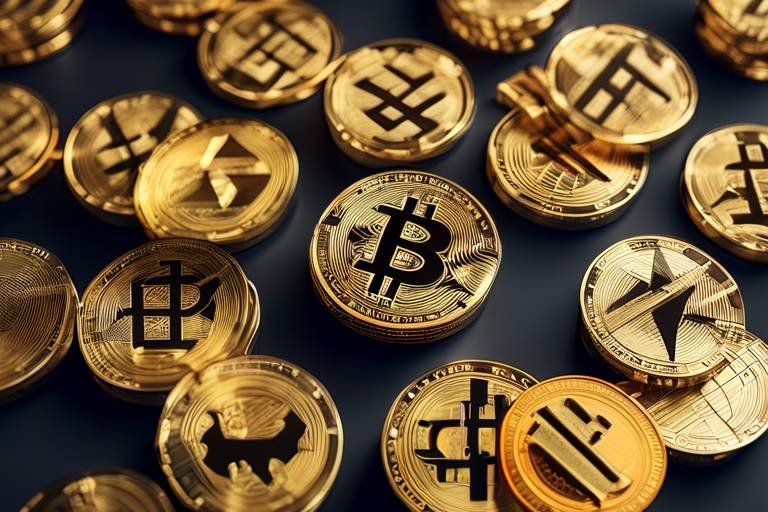Market Analysis - Identifying Emerging Crypto Sectors
As we dive into the exhilarating world of cryptocurrency, it's hard not to feel a sense of anticipation about what the future holds. The digital currency landscape is constantly evolving, with new trends emerging almost daily. For investors and enthusiasts alike, understanding these trends is crucial for pinpointing potential growth areas. In this article, we will explore the latest trends in the cryptocurrency market, focusing on the sectors that are not just surviving but thriving. By identifying these emerging sectors, we can uncover exciting investment opportunities that could yield significant returns.
Imagine standing at the edge of a vast ocean, with waves of innovation crashing at your feet. Each wave represents a new trend, a new technology, or a new opportunity waiting to be seized. The key is to recognize which waves are worth riding and which ones might pull you under. This requires a keen eye for detail and an understanding of the underlying forces driving these changes. From decentralized finance (DeFi) to non-fungible tokens (NFTs), the cryptocurrency market is a treasure trove of potential waiting to be explored.
In this analysis, we will take a closer look at the current trends shaping the cryptocurrency landscape. We will dissect the innovative technologies that are driving these trends and highlight the sectors that show the most promise for future growth. By the end of this article, you'll have a clearer picture of where to focus your attention and investment efforts in the ever-changing world of cryptocurrency.
So, grab your surfboard and get ready to ride the waves of change as we explore the exciting world of emerging crypto sectors!
Analyzing the current trends in cryptocurrency helps investors identify which sectors are gaining traction and which technologies are driving innovation in the market. The cryptocurrency ecosystem is a complex web of interrelated components, each influencing the other in ways that can be both subtle and profound. By understanding these trends, investors can position themselves advantageously and capitalize on the opportunities that arise.
The cryptocurrency market is often characterized by its volatility, which can be both a risk and an opportunity. For instance, while prices can fluctuate wildly in the short term, they often reflect deeper trends that indicate where the market is heading. By keeping a pulse on these trends, investors can make informed decisions about where to allocate their resources. This requires a blend of market analysis, technological understanding, and a bit of intuition.
This section highlights the most promising sectors within the cryptocurrency landscape, detailing their unique attributes and potential for future growth. As we explore these sectors, it's essential to keep in mind the broader context of the cryptocurrency market and how these emerging areas fit into the larger picture.
Decentralized Finance, or DeFi, has transformed traditional finance by offering decentralized solutions that eliminate intermediaries. This sector has gained immense popularity due to its ability to provide financial services without the need for banks or other traditional financial institutions. The growth potential of DeFi is staggering, with billions of dollars locked in various DeFi protocols. However, it also faces challenges, such as regulatory scrutiny and security vulnerabilities.
Yield farming allows users to earn rewards on their crypto holdings by lending them out or providing liquidity. This innovative approach to earning passive income has attracted many investors looking to maximize their returns. Yield farming can be likened to planting seeds in a garden; with the right conditions, those seeds can grow into a bountiful harvest. However, just as in gardening, there are risks involved, and investors must be cautious about where they plant their seeds.
Liquidity pools are vital for DeFi platforms, acting as reserves that facilitate transactions and trading. These pools enable users to provide liquidity in exchange for rewards, creating a win-win situation for both users and platforms. Imagine a bustling marketplace where everyone has something to trade; liquidity pools ensure that there are enough goods available for everyone to make their trades smoothly. They play a crucial role in maintaining the overall health of the DeFi ecosystem.
Non-Fungible Tokens (NFTs) have revolutionized digital ownership and creativity, allowing artists and creators to tokenize their work. This sector has seen explosive growth, with NFTs being used in various applications, from art and music to gaming and virtual real estate. The uniqueness of NFTs is akin to owning a one-of-a-kind piece of art; each token represents something special that cannot be replicated. As more creators enter the space, the market for NFTs is expected to expand further, offering exciting opportunities for investors.
Understanding the regulatory landscape is crucial for investors navigating the cryptocurrency market. Regulations can significantly impact emerging sectors, influencing everything from market stability to investment strategies. As governments around the world grapple with how to regulate cryptocurrencies, staying informed about these changes is essential for anyone looking to invest.
Different countries approach cryptocurrency regulation differently, creating a patchwork of laws and guidelines. This subsection analyzes the global trends and their implications for emerging sectors. For instance, while some countries embrace cryptocurrencies and blockchain technology, others impose strict regulations that can stifle innovation. Understanding these trends can help investors identify which regions are more favorable for investment.
Regulatory changes can significantly influence investment strategies. Here, we explore how investors can adapt to these changes to maximize their returns. Just as a sailor adjusts their sails according to the wind, investors must be agile and responsive to the regulatory environment. By staying informed and being willing to pivot, investors can position themselves for success in the ever-changing cryptocurrency landscape.
Q1: What are the main sectors in cryptocurrency?
A1: The main sectors include Decentralized Finance (DeFi), Non-Fungible Tokens (NFTs), and various blockchain applications.
Q2: How can I invest in emerging crypto sectors?
A2: You can invest by purchasing cryptocurrencies, participating in DeFi protocols, or buying NFTs through various marketplaces.
Q3: What are the risks associated with cryptocurrency investment?
A3: Risks include market volatility, regulatory changes, and potential security vulnerabilities in platforms.
Q4: How do regulations affect cryptocurrency?
A4: Regulations can impact market stability, investment strategies, and the overall growth of the cryptocurrency ecosystem.

Understanding Cryptocurrency Trends
In the ever-evolving world of cryptocurrency, staying ahead of the curve is essential for investors and enthusiasts alike. The market is akin to a roller coaster, filled with exhilarating highs and daunting lows. To navigate this thrilling ride, one must understand the prevailing trends that shape the landscape. A keen analysis of these trends not only reveals which sectors are gaining momentum but also uncovers the technologies driving this innovation.
One of the most significant trends in the cryptocurrency market is the shift towards decentralization. Traditional financial systems often rely on centralized authorities, but cryptocurrencies challenge this norm by promoting peer-to-peer transactions. This shift has empowered individuals, allowing them to take control of their finances without intermediaries. It's like moving from a crowded subway to a personal vehicle; you gain freedom and flexibility in how you manage your assets.
Moreover, the rise of blockchain technology has been a game changer. Its applications extend far beyond cryptocurrencies, influencing various sectors such as supply chain management, healthcare, and even voting systems. By providing transparency and security, blockchain is paving the way for innovative solutions that could redefine entire industries. Think of it as the foundation of a new digital city, where trust and efficiency are built into the very walls.
Another trend worth noting is the increasing interest in institutional investment. Major financial institutions are starting to recognize the potential of cryptocurrencies, leading to a surge in investment from hedge funds, banks, and even pension funds. This influx of capital not only legitimizes the market but also enhances its stability. It's like having a seasoned coach join a young sports team; their experience can guide the team to victory while attracting even more talent.
As we delve deeper into the trends, it's also important to highlight the growing interest in sustainable cryptocurrencies. With the environmental impact of mining operations coming under scrutiny, many new projects are focusing on eco-friendly solutions. This trend reflects a broader societal shift towards sustainability, where investors are increasingly considering the environmental, social, and governance (ESG) aspects of their investments. Imagine planting a garden where every flower not only beautifies the space but also contributes to the ecosystem; this is the future of responsible investing in crypto.
In summary, understanding these trends is crucial for anyone looking to invest in the cryptocurrency market. By keeping an eye on decentralization, blockchain applications, institutional investments, and sustainable practices, investors can better position themselves to capitalize on emerging opportunities. As the market continues to evolve, those who adapt and embrace these changes will undoubtedly reap the rewards.
- What are the key trends in cryptocurrency right now? The key trends include decentralization, blockchain technology applications, institutional investment, and sustainable cryptocurrencies.
- Why is decentralization important? Decentralization empowers individuals by allowing them to manage their finances without relying on central authorities, promoting more control and privacy.
- How does blockchain technology influence other sectors? Blockchain technology enhances transparency and security, making it applicable in various fields like supply chain management, healthcare, and voting systems.
- What is the significance of institutional investment in crypto? Institutional investment legitimizes the cryptocurrency market and brings stability through increased capital and expertise.
- What is meant by sustainable cryptocurrencies? Sustainable cryptocurrencies focus on eco-friendly practices and aim to minimize the environmental impact of mining and transactions.

Key Emerging Sectors
As we dive into the exciting world of cryptocurrency, it's essential to spotlight the that are not only gaining traction but also reshaping the landscape of digital finance. These sectors are akin to hidden gems in a vast ocean, waiting for savvy investors to uncover their potential. Each sector brings unique attributes and opportunities, making them worthy of attention in your investment strategy. In this rapidly evolving market, understanding these sectors can be the difference between riding the wave of innovation and getting lost in the tide of uncertainty.
Among the most promising areas are Decentralized Finance (DeFi), Non-Fungible Tokens (NFTs), and the burgeoning field of Blockchain Gaming. Each of these sectors has its own flavor and appeal, attracting a diverse range of investors and users. Let’s break down these sectors a bit more to see what makes them tick.
DeFi is revolutionizing traditional finance by creating an ecosystem where financial services are accessible to anyone with an internet connection. Imagine being able to borrow, lend, and earn interest on your assets without the need for banks or intermediaries. This sector has exploded in popularity, offering innovative solutions that empower users to take control of their financial destinies.
One of the standout features of DeFi is yield farming. This process allows users to earn rewards on their crypto holdings by providing liquidity to various protocols. Think of it as planting seeds in a garden; the more you nurture your investments, the more fruitful your yield will be. Yield farming can be a lucrative venture, but it also comes with risks, such as impermanent loss and market volatility. Thus, understanding the underlying mechanics is crucial for success.
Another critical component of DeFi is liquidity pools. These pools are collections of funds locked in smart contracts, used to facilitate trading on decentralized exchanges. They are the lifeblood of DeFi platforms, providing the liquidity necessary for seamless transactions. Users who contribute to these pools are often rewarded with transaction fees and governance tokens, creating a symbiotic relationship between users and platforms. This dynamic not only enhances user engagement but also fosters a decentralized ecosystem.
The rise of NFTs has brought a new dimension to digital ownership and creativity. Unlike cryptocurrencies like Bitcoin, which are fungible and can be exchanged one-for-one, NFTs represent unique assets that cannot be replicated. This uniqueness has opened up a world of possibilities, from digital art and collectibles to virtual real estate and gaming items. The market for NFTs has skyrocketed, attracting artists, collectors, and investors alike, all eager to participate in this digital renaissance.
As we look to the future, the potential applications of NFTs are vast. They can serve as proof of ownership, enable royalties for creators, and even provide access to exclusive content or experiences. The integration of NFTs into various industries, such as gaming, music, and fashion, suggests that this sector is only just beginning to scratch the surface of its potential.
In summary, the key emerging sectors within the cryptocurrency landscape are not just trends; they represent fundamental shifts in how we interact with finance, art, and technology. By keeping a close eye on DeFi, NFTs, and other innovative areas, investors can position themselves to capitalize on the next wave of growth in this dynamic market.
- What is DeFi? - DeFi stands for Decentralized Finance, which refers to financial services that are built on blockchain technology and operate without traditional intermediaries.
- How does yield farming work? - Yield farming allows users to earn interest or rewards by providing liquidity to DeFi platforms, typically by locking their crypto assets in liquidity pools.
- What are NFTs? - Non-Fungible Tokens are unique digital assets that represent ownership of a specific item or piece of content, such as art, music, or virtual goods.
- Are NFTs a good investment? - Like any investment, the value of NFTs can be volatile. It's essential to do thorough research and understand the market before investing.

Decentralized Finance (DeFi)
Decentralized Finance, or DeFi, is like the wild west of the financial world, where traditional banking systems are turned upside down. Imagine a place where you can lend, borrow, and trade without the need for a middleman—sounds liberating, right? DeFi has emerged as a transformative force in the cryptocurrency landscape, leveraging blockchain technology to create an open financial system that is accessible to anyone with an internet connection. This shift is not just a trend; it's a revolution that promises to democratize finance, offering services that were once exclusive to banks and financial institutions.
At its core, DeFi aims to replace traditional financial intermediaries with smart contracts—self-executing contracts with the terms of the agreement directly written into code. This means that users can interact directly with each other, eliminating the need for banks or brokers. The potential for innovation and growth in this sector is staggering, as it opens up a world of possibilities for financial transactions, investment opportunities, and asset management.
However, like any burgeoning sector, DeFi isn't without its challenges. Issues such as security vulnerabilities, regulatory scrutiny, and liquidity risks loom large. As DeFi platforms gain popularity, they also attract the attention of hackers and malicious actors, making security a top priority for developers and users alike. Furthermore, the lack of clear regulations can create uncertainty, leaving investors and developers navigating a complex legal landscape.
| Challenges in DeFi | Implications |
|---|---|
| Security Vulnerabilities | Risk of hacks and loss of funds |
| Regulatory Scrutiny | Potential for restrictive laws affecting operations |
| Liquidity Risks | Difficulty in executing trades during market fluctuations |
Despite these challenges, the growth potential of DeFi is immense. According to recent reports, the total value locked (TVL) in DeFi protocols has skyrocketed, indicating a strong interest from investors and users. As more people become aware of the benefits of decentralized finance, we can expect to see an influx of new projects and innovations aimed at enhancing user experience and security.
In conclusion, DeFi represents a paradigm shift in how we think about finance. By removing intermediaries and enabling peer-to-peer transactions, it has the potential to create a more inclusive financial system. As we continue to explore the possibilities of DeFi, one thing is clear: this sector is not just a passing trend; it's here to stay, and its impact on the financial landscape will only grow stronger.
- What is DeFi? DeFi stands for Decentralized Finance, which refers to financial services that operate on a blockchain without intermediaries.
- How does DeFi work? DeFi uses smart contracts on blockchain platforms to facilitate transactions, allowing users to lend, borrow, and trade directly with each other.
- What are the risks associated with DeFi? Risks include security vulnerabilities, regulatory challenges, and liquidity issues that can affect the stability of DeFi platforms.

Yield Farming
Yield farming has emerged as a pivotal component in the decentralized finance (DeFi) ecosystem, providing users with the opportunity to earn passive income on their cryptocurrency holdings. But what exactly is yield farming? In simple terms, it involves lending or staking your cryptocurrency assets in a DeFi protocol to generate returns, often in the form of additional cryptocurrency. This process is akin to traditional farming, where you plant seeds (your crypto) and harvest crops (the rewards) over time. The beauty of yield farming lies in its potential for high returns, but it also comes with its own set of risks and complexities.
To understand yield farming more clearly, let’s break down how it works. When you participate in yield farming, you typically deposit your cryptocurrencies into a liquidity pool. These pools are essential for DeFi platforms, as they provide the liquidity necessary for transactions. In return for supplying liquidity, you earn rewards, which can be significantly higher than traditional savings accounts or investment vehicles. In fact, some yield farmers report annual percentage yields (APYs) that can reach into the hundreds or even thousands of percent!
However, it’s crucial to keep in mind that yield farming isn’t without its challenges. The DeFi space is still relatively new and can be highly volatile. Smart contract vulnerabilities can lead to losses, and the value of the tokens you earn can fluctuate dramatically. Therefore, it’s essential to conduct thorough research before diving into yield farming. Here are some key considerations to keep in mind:
- Understand the Risks: High returns often come with high risks. Be prepared for the possibility of losing your investment.
- Choose Reputable Platforms: Not all DeFi platforms are created equal. Look for well-established protocols with a good track record.
- Diversify Your Investments: Just like in traditional investing, don’t put all your eggs in one basket. Spread your investments across different platforms and tokens.
In summary, yield farming represents an exciting frontier in the world of cryptocurrency and DeFi. While it offers the potential for substantial rewards, it’s essential to approach it with caution and a well-informed strategy. By understanding the mechanics behind yield farming and the associated risks, you can position yourself to take advantage of this innovative financial opportunity.
What is yield farming? Yield farming is the practice of lending or staking cryptocurrency assets in DeFi protocols to earn rewards, often in the form of additional cryptocurrency.
Is yield farming safe? While yield farming can offer high returns, it also carries significant risks, including the potential for loss due to market volatility and smart contract vulnerabilities.
How can I get started with yield farming? To start yield farming, choose a reputable DeFi platform, deposit your cryptocurrency into a liquidity pool, and monitor your investments regularly.

Liquidity Pools
Liquidity pools are a cornerstone of the decentralized finance (DeFi) ecosystem, acting as the lifeblood that keeps these platforms functioning smoothly. Imagine a vast ocean where various boats (or tokens) can freely sail; this ocean is the liquidity pool. Essentially, a liquidity pool is a collection of funds locked in a smart contract that provides liquidity for decentralized exchanges (DEXs) and other DeFi applications. Without these pools, trading would be much less efficient, and users would face higher slippage and transaction costs.
So, how do liquidity pools actually work? When users provide their cryptocurrencies to a liquidity pool, they are essentially depositing their assets into a communal fund. In return for their contribution, they receive liquidity provider (LP) tokens, which represent their share of the pool. These LP tokens can be used to redeem the original assets plus any fees generated from trades that occur in the pool. It’s a win-win situation: the liquidity providers earn rewards while traders benefit from increased liquidity and reduced price volatility.
However, it's essential to understand that participating in liquidity pools is not without risks. One of the most significant risks is impermanent loss, which occurs when the price of the deposited assets changes compared to when they were deposited. This can lead to a situation where liquidity providers end up with less value than if they had simply held onto their assets. Despite this risk, many users are drawn to liquidity pools due to the potential for earning yield through transaction fees and incentives offered by various DeFi platforms.
To illustrate the workings of liquidity pools, consider the following table:
| Aspect | Description |
|---|---|
| Definition | A collection of funds locked in a smart contract to facilitate trading on DEXs. |
| LP Tokens | Tokens issued to liquidity providers representing their share of the pool. |
| Rewards | Earned through transaction fees and potential incentives from DeFi platforms. |
| Risks | Includes impermanent loss and smart contract vulnerabilities. |
In conclusion, liquidity pools are vital for the success of DeFi platforms, providing the necessary liquidity for users to trade efficiently. While they offer exciting opportunities for earning rewards, it's crucial for participants to be aware of the associated risks and to conduct thorough research before diving in. Ultimately, understanding the dynamics of liquidity pools can empower investors and traders to make informed decisions in the ever-evolving landscape of cryptocurrency.
- What is a liquidity pool? A liquidity pool is a collection of funds locked in a smart contract that facilitates trading on decentralized exchanges.
- How do I earn rewards from liquidity pools? By providing liquidity, you earn transaction fees and may receive additional incentives from the platform.
- What is impermanent loss? Impermanent loss occurs when the value of your assets changes after being deposited into a liquidity pool, potentially leading to a loss compared to holding the assets.
- Are liquidity pools safe? While liquidity pools can offer rewards, they carry risks, including impermanent loss and vulnerabilities in smart contracts. Always do your research!

Non-Fungible Tokens (NFTs)
Non-Fungible Tokens, or NFTs, have taken the digital world by storm, revolutionizing the way we perceive ownership and creativity. Unlike cryptocurrencies such as Bitcoin or Ethereum, which are fungible and can be exchanged for one another, NFTs are unique digital assets that represent ownership of a specific item or piece of content, whether it's art, music, videos, or even virtual real estate. Imagine owning a one-of-a-kind painting; that’s the essence of NFTs in the digital realm.
The rise of NFTs has opened up a plethora of opportunities for artists, creators, and collectors alike. Artists can tokenize their work, allowing them to sell directly to consumers without intermediaries, thus retaining a larger share of the profits. This shift has democratized the art world, giving a voice to emerging artists who previously struggled to gain recognition. Moreover, collectors can now own exclusive pieces of digital art, a concept that was nearly impossible before the advent of NFTs.
However, the NFT market is not without its challenges. The volatility of prices can be alarming; some NFTs have sold for millions, while others may struggle to find buyers. Additionally, the environmental impact of blockchain technology, particularly in terms of energy consumption, has raised eyebrows and sparked debate among enthusiasts and critics alike. To navigate this complex landscape, it's crucial to understand the various applications and implications of NFTs.
Here are some key applications of NFTs:
- Digital Art: Artists can create digital works and sell them as NFTs, ensuring authenticity and ownership.
- Music: Musicians can release tracks as NFTs, giving fans a unique way to support their favorite artists.
- Gaming: In-game assets can be tokenized, allowing players to truly own their items and trade them across platforms.
- Virtual Real Estate: Platforms like Decentraland allow users to buy, sell, and develop virtual land as NFTs.
As we look to the future, the potential for NFTs seems limitless. They are not just a passing trend; they represent a fundamental shift in how we think about ownership and value in the digital age. Whether you are an artist, a collector, or simply a curious observer, understanding NFTs is essential to grasping the future of creativity and commerce.
What is an NFT?
An NFT, or Non-Fungible Token, is a unique digital asset that represents ownership of a specific item or piece of content on a blockchain.
How do NFTs work?
NFTs work by utilizing blockchain technology to provide a secure and verifiable record of ownership, ensuring that each token is distinct and cannot be replicated.
Can I create my own NFT?
Yes, anyone can create their own NFT by minting it on a blockchain platform that supports NFT creation, such as Ethereum.
Are NFTs a good investment?
Like any investment, NFTs come with risks. While some have seen significant returns, the market is highly volatile, and prices can fluctuate dramatically.
What are the environmental concerns related to NFTs?
The energy consumption associated with blockchain transactions, particularly on proof-of-work networks, has raised concerns about the environmental impact of NFTs.

Regulatory Considerations
When diving into the world of cryptocurrencies, one cannot overlook the importance of . The cryptocurrency landscape is continuously evolving, and with it comes a wave of regulations that can significantly impact the market. Understanding these regulations is crucial for investors who want to navigate this complex environment successfully. It’s like trying to find your way through a maze; having a map (or in this case, knowledge of regulations) can make all the difference in avoiding dead ends.
Regulations can vary dramatically from one country to another, creating a patchwork of rules that can be perplexing. For instance, some nations embrace cryptocurrencies with open arms, while others impose strict limitations or outright bans. This divergence can lead to significant implications for investors and businesses alike. For example, a favorable regulatory environment can stimulate innovation and attract investment, whereas stringent regulations may stifle growth and drive businesses to more crypto-friendly jurisdictions.
Let’s take a closer look at some of the global regulatory trends that are shaping the cryptocurrency market:
| Region | Regulatory Approach | Impact on Market |
|---|---|---|
| United States | Mixed; some states are friendly, while others are not | Encourages innovation but creates uncertainty |
| European Union | Progressive; working on comprehensive regulations | Potentially creates a unified market |
| China | Restrictive; banning most crypto activities | Drives innovation underground |
| El Salvador | Proactive; adopting Bitcoin as legal tender | Attracts investment and tourism |
As you can see from the table, the regulatory landscape is diverse, and each region's approach can significantly influence the market dynamics. Investors need to stay informed about these developments to make strategic decisions. It’s crucial to remember that regulations are not static; they evolve as governments and regulatory bodies respond to the fast-paced nature of cryptocurrency.
Moreover, the impact on investment strategies cannot be overstated. Regulatory changes can lead to shifts in market sentiment, affecting everything from asset prices to the viability of certain projects. Investors must be agile and ready to adapt their strategies in response to regulatory news. For instance, if a country announces favorable regulations for crypto businesses, it might be a good time to invest in related assets. Conversely, negative news could signal a need to reevaluate one’s portfolio.
In conclusion, staying abreast of regulatory considerations is not just a good practice; it’s essential for anyone looking to thrive in the cryptocurrency market. By understanding the implications of regulations, investors can make informed decisions that align with the evolving landscape. So, keep your ear to the ground and your eyes on the news—because in the world of crypto, knowledge truly is power.
- What are the main regulatory bodies overseeing cryptocurrency?
In many countries, regulatory bodies such as the SEC (Securities and Exchange Commission) in the U.S. and the FCA (Financial Conduct Authority) in the U.K. are key players in overseeing cryptocurrency regulations. - How do regulations affect cryptocurrency prices?
Regulations can create uncertainty or confidence in the market, which can lead to price fluctuations. Positive regulatory news often boosts prices, while negative news can cause declines. - Can regulations stifle innovation in the crypto space?
Yes, overly strict regulations can hinder innovation by making it difficult for startups to operate. However, well-balanced regulations can encourage growth and protect investors.

Global Regulatory Trends
The world of cryptocurrency is as dynamic as it is complex, and one of the most significant factors influencing its evolution is regulatory trends. As digital currencies gain popularity, governments and regulatory bodies across the globe are grappling with how to manage this burgeoning market. The challenge lies in balancing innovation with consumer protection, which often leads to a patchwork of regulations that can vary dramatically from one country to another. For instance, while some nations have embraced cryptocurrencies with open arms, others have taken a more cautious or even hostile stance.
In the United States, the regulatory landscape is evolving rapidly, with agencies like the Securities and Exchange Commission (SEC) and the Commodity Futures Trading Commission (CFTC) stepping up their efforts to provide clarity. This has resulted in a series of guidelines aimed at defining what constitutes a security in the crypto space. In contrast, countries like China have implemented strict bans on cryptocurrency trading and Initial Coin Offerings (ICOs), reflecting a more stringent approach to regulation.
To better understand these global regulatory trends, let’s take a look at some key regions and their stances on cryptocurrency:
| Region | Regulatory Approach | Key Developments |
|---|---|---|
| United States | Increasing regulation with a focus on consumer protection | SEC guidelines on securities, IRS taxation policies |
| European Union | Proposed MiCA regulations to unify crypto laws | Focus on anti-money laundering and consumer protection |
| China | Strict bans on crypto trading and ICOs | Government crackdown on mining and exchanges |
| Japan | Progressive regulation with licensing for exchanges | Legal recognition of cryptocurrencies as a payment method |
As we can see, the regulatory landscape is not only diverse but also constantly changing. This fluidity can create both opportunities and challenges for investors. For instance, as regulations tighten in certain regions, there may be a flight of capital to more favorable jurisdictions. This could lead to the emergence of new crypto hubs, where innovation can thrive without the burden of excessive regulation. Conversely, a lack of regulation in some areas can expose investors to risks, such as fraud and market manipulation.
It's essential for investors to stay informed about these trends, as they can significantly impact the viability and success of different sectors within the cryptocurrency market. Understanding how regulations evolve will help investors make more informed decisions, ensuring they are not caught off guard by sudden changes that could affect their investments.
In summary, the global regulatory trends surrounding cryptocurrency are a double-edged sword. While they can provide a framework for safe investing, they also pose challenges that require careful navigation. As we move forward, the key will be to stay abreast of these developments and adapt investment strategies accordingly. After all, in the ever-changing world of crypto, knowledge is power.
- What are the main regulatory bodies overseeing cryptocurrency?
The main regulatory bodies include the SEC and CFTC in the United States, the European Securities and Markets Authority (ESMA) in Europe, and various national regulators worldwide.
- How do regulations affect cryptocurrency investments?
Regulations can impact the legality of certain activities, influence market stability, and determine the level of consumer protection, all of which affect investment strategies.
- Are there countries with favorable regulations for cryptocurrencies?
Yes, countries like Japan and Switzerland have established favorable regulatory environments that encourage cryptocurrency innovation and investment.

Impact on Investment Strategies
As the cryptocurrency landscape evolves, so too do the strategies that investors employ to navigate this dynamic market. The impact of regulatory changes on investment strategies cannot be overstated. Investors must remain vigilant and adaptable, as regulations can shift the entire playing field, affecting everything from asset valuation to market accessibility. For instance, when a country introduces new regulations, it often leads to a ripple effect that influences investor sentiment and market behavior. This is akin to a sudden change in weather; just as a storm can alter the course of a sailing journey, regulatory shifts can redirect investment strategies.
One of the key considerations for investors is to stay informed about both local and global regulatory trends. For example, if a major economy like the United States tightens its regulations on cryptocurrency exchanges, investors might see a decrease in trading volumes and liquidity in the market. Consequently, this could prompt a reevaluation of investment portfolios and strategies. Investors might need to shift from aggressive trading to a more conservative approach, focusing on assets that are less susceptible to regulatory scrutiny.
Moreover, the introduction of regulations can create new opportunities. For example, with the rise of compliance-focused projects, investors might find value in platforms that prioritize transparency and adhere to regulatory standards. This is particularly true in sectors like Decentralized Finance (DeFi) and Non-Fungible Tokens (NFTs), where the legitimacy of projects can significantly impact their market performance. Therefore, investors should consider the regulatory landscape when evaluating potential investments.
Another critical aspect is the diversification of investment strategies. In a market characterized by volatility and uncertainty, diversification acts as a safety net. Investors might want to explore a mix of traditional assets and cryptocurrencies, ensuring they are not overly exposed to any single sector. This approach can help mitigate risks associated with sudden regulatory changes. A well-diversified portfolio might include:
- Established cryptocurrencies like Bitcoin and Ethereum
- Emerging DeFi projects
- Promising NFT platforms
- Stablecoins for liquidity and stability
Furthermore, investors should also consider adopting a long-term perspective. While regulatory news can cause short-term price fluctuations, a focus on long-term value can provide a clearer path through the noise. By identifying projects with solid fundamentals and regulatory compliance, investors can position themselves for sustained growth, rather than getting swept up in the hype of quick gains.
Lastly, engaging with the community and staying updated through reliable sources is vital. Active participation in forums, attending webinars, and following regulatory bodies can provide insights that are crucial for making informed decisions. Knowledge is power, especially in a field as rapidly changing as cryptocurrency. By staying ahead of the curve, investors can better anticipate changes and adapt their strategies accordingly.
Q1: How do regulatory changes affect cryptocurrency investments?
Regulatory changes can impact market sentiment, liquidity, and asset valuations, prompting investors to adjust their strategies accordingly.
Q2: What should I consider when diversifying my crypto portfolio?
Consider a mix of established cryptocurrencies, emerging projects, and stablecoins to mitigate risks associated with volatility.
Q3: How can I stay updated on regulatory changes?
Engaging with the cryptocurrency community, following news outlets, and subscribing to updates from regulatory bodies can help keep you informed.
Frequently Asked Questions
- What is DeFi and why is it important?
Decentralized Finance (DeFi) is a revolutionary movement within the cryptocurrency space that aims to recreate traditional financial systems using decentralized technologies. It allows users to lend, borrow, and trade assets without intermediaries, which can lead to lower costs and greater accessibility. The significance of DeFi lies in its potential to democratize finance and provide services to those who are unbanked or underbanked.
- How does yield farming work?
Yield farming is a method where users can earn rewards by providing liquidity to DeFi protocols. Essentially, you lock up your cryptocurrencies in a smart contract, which then uses those funds to facilitate transactions or offer loans. In return, you earn interest or tokens as rewards, making it an attractive option for those looking to maximize their crypto holdings.
- What are liquidity pools?
Liquidity pools are collections of funds locked in a smart contract that facilitate trading on decentralized exchanges. They provide the liquidity necessary for trades to occur without the need for a traditional market maker. Users who contribute to these pools earn a share of the transaction fees, making them an essential component of the DeFi ecosystem.
- What are NFTs and how do they work?
Non-Fungible Tokens (NFTs) are unique digital assets that represent ownership of a specific item or piece of content, such as art, music, or virtual real estate. Unlike cryptocurrencies like Bitcoin, which are fungible and can be exchanged for one another, NFTs are one-of-a-kind and cannot be replaced. This uniqueness is what gives them value and has led to a booming market for digital collectibles.
- How do regulations impact the cryptocurrency market?
Regulations play a crucial role in shaping the cryptocurrency landscape. They can affect everything from how cryptocurrencies are traded to the legitimacy of certain projects. Understanding the regulatory environment helps investors make informed decisions and adapt their strategies to stay compliant while maximizing potential returns.
- What are the global regulatory trends for cryptocurrencies?
Different countries have varying approaches to cryptocurrency regulation. Some nations are embracing digital currencies and creating frameworks to support innovation, while others are imposing strict regulations or outright bans. Keeping an eye on these trends can help investors understand the potential risks and opportunities in different markets.
- How can investors adapt their strategies to regulatory changes?
Investors can adapt to regulatory changes by staying informed about the latest developments and being flexible in their investment strategies. This might involve diversifying their portfolios, focusing on projects that comply with regulations, or even shifting their investments to more favorable jurisdictions. Being proactive can help mitigate risks associated with sudden regulatory shifts.



















